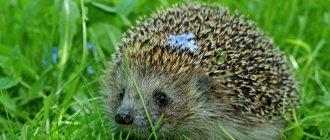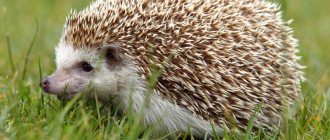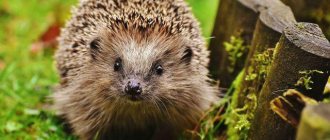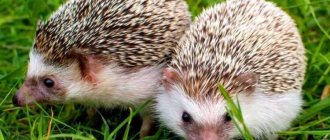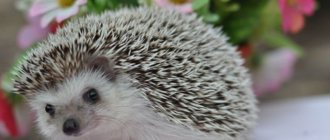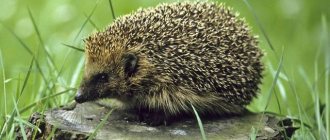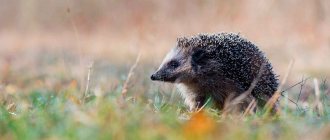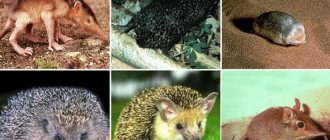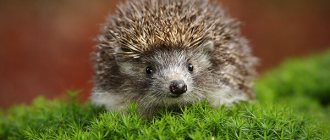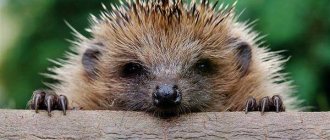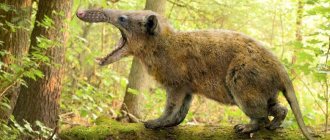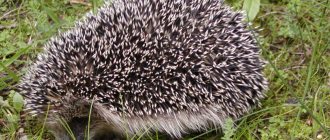The Daurian hedgehog is an animal whose current population in South-Eastern Transbaikalia is estimated at approximately 550-650 thousand individuals, which made it possible to include the hedgehog in the Red Book.
The Daurian hedgehog lives in the Primorsky Territory, Chita and Amur regions, as well as in Transbaikalia. Outside our country, Daurian hedgehogs live in Manchuria, Mongolia and China.
The natural habitat of Daurian hedgehogs is steppes, semi-deserts and mountain rocky areas. They are found on the slopes of hills and in ravines with thickets of cotoneaster and almond. They often settle next to people. Daurian hedgehogs avoid places with thick, dense grass.
Daurian hedgehog (Mesechinus dauuricus).
Description
The Daurian hedgehog is a representative of the order of hedgehogs and is similar to its relatives in almost everything. The only distinctive feature is the absence of a bare strip of skin on the head, which is present in all hedgehogs, as well as reduced pricklyness due to the needles, the growth of which is directed backwards.
In all other respects, the Daurian hedgehog (photo in the article) is a familiar animal with a cone-shaped head of straw-whitish color and a moderately elongated muzzle. The size of its body is about 25 cm, the tail is up to 3.7 cm. Small ears (up to 3 cm) are bent forward, but do not touch the eyes. The color of the fur varies from light sandy to dark brown; the needles are endowed with one or two longitudinal stripes. The presence of ring muscles under the shell allows the animal to easily curl up into a tight ball.
The weight of a hedgehog is 600-1200 grams and depends on the time of year. During the hibernation period, body weight is minimal, and by the end of autumn, on the contrary, due to preparation for the long winter period, the hedgehog accumulates the necessary grams.
Security
The main protected area for these animals is the Daursky Nature Reserve. The Daurian hedgehog in the reserve is not only protected, it is studied and everything is done to preserve and even increase the population. In the protected zone, measures are taken to prevent fires; there are strict restrictions on the use of chemicals, even for nearby agricultural land.
Habitat
The habitat of the Daurian hedgehog is the territory of Russia, namely the Chita and Amur regions, Primorsky Krai, Central and Southern Transbaikalia, part of the territory of which was previously called Daurian land. This gave the name to the animals living in its areas: white-naped marmot, white-naped crane, white-naped hedgehog (photo provided).
The spiky beauty can also be found in Eastern Mongolia, Manchuria and Northeast China. True, encounters are not as frequent as we would like, since in the 60s of the last century, the habitats of the Daurian hedgehog were treated with strong pesticides, which resulted in the death of a huge number of representatives of this class of animals. In this case, the hedgehog turned out to be an accidental victim, since the effect of the toxic substances was directed against the carriers of the plague - field rodents.
In its natural environment, the habitat of the Dahurian hedgehog is steppe areas, as well as semi-desert and mountainous areas with rocky areas. It settles in abandoned rodent burrows, does not shy away from dense bushes, natural niches in the soil and under stones. Avoids areas with dense grass. Often the homes of the spiky beauty are located near human habitation. This is explained by the absence of predators, the presence of secluded shelters and sufficient food.
Diet
The Daurian hedgehog has a fairly varied menu. It consumes bird eggs and even hatched small chicks. Eats many insects: beetles, ants and ground beetles. Can catch a snake, hamster or frog. Vegetation preferences include rose hips, cotoneaster and almonds.
However, if difficult times come, the animal can even eat carrion.
Large and healthy males have a habitat that can reach 400 hectares.
Danger factors for the Daurian hedgehog
By the way, dangers await the Daurian hedgehog at every step. On the animal side, these are fox, wolf, steppe ferret, dogs kept without a leash. It is difficult for a hedgehog to escape from a badger that can get it out of deep holes. Of the winged representatives, the hedgehog is afraid of the steppe eagle, the long-legged buzzard, and the eagle owl.
Forest and steppe fires, pesticides used, and agricultural harvesting activities have a significant impact on population decline.
A lesser degree of danger for hedgehogs is posed by roads, which cause death from the wheels of vehicles, as well as by catching them and keeping them in captivity, in conditions in which they can live up to 8 years. In the natural environment, life expectancy is an order of magnitude shorter and is 3–4 years.
The above factors became the basis for people to control how and where the Daurian hedgehog lives. The Red Book perpetuated the need to take care of such an endangered representative of the animal world.
The Daurian hedgehog is characterized by a crepuscular lifestyle. He does not like humidity, so he avoids damp places and sits in a shelter if it rains. But in cloudy weather it is active even during the daytime.
The Daurian hedgehog goes into hibernation in August–October and emerges from this state around the end of April.
Adult males are the first to go to sleep in August; young individuals - around October. The awakening for Daurian hedgehogs is simultaneous and occurs approximately in the second half of April.
Population size
In the mid-1960s, the Daurian urchin population declined sharply due to heavy use of pesticides in Russia. Since then, the population appears to have recovered, although it has not reached its previous size. Now the Daurian hedgehog seems to continue to spread in the northern regions. In southeastern Transbaikalia, the hedgehog population is estimated at 550,000 to 650,000 individuals. Due to low population densities in these areas, the species' abundance in most regions is unclear.
It is included in the IUCN Red List with the status of “least concern”, as well as in the Red Book of the Russian Federation as a vulnerable protected species with an uncertain status.
Reproduction
In nature, Daurian hedgehogs live separately, but during the mating period, which begins at the end of May, the pair lives together for several days.
The female usually lives in abandoned rodent burrows or digs a shelter on her own. The gestation period of a hedgehog is 37-40 days, usually in June - July new offspring are born in the amount of 4 - 7 cubs. They are born blind, their eyes begin to open on the 16th day. Also, babies at birth have a bright pink skin color and no needles at all. They begin to grow several hours after birth. The female is characterized by especially reverent care for her offspring and, at the slightest danger, transfers her babies to a new den.
Hedgehogs grow quite quickly and begin to emerge from their burrows at the age of one month. They finally separate from the mother at 7–8 weeks, beginning an independent life. Young males reach sexual maturity at 11 months, but competition with older individuals does not allow them to take part in reproduction for approximately 2 years.
The image of the Daurian hedgehog is immortalized on a commemorative silver coin from the “Red Book” series with a face value of 1 ruble, issued in Russia in 1999 in a limited edition.
Appearance
The long-eared hedgehog is distinguished by very large ears (ear length 3–5 cm). They are not only an organ of hearing, but also help the animal regulate body temperature, preventing overheating. In them, near the surface of the skin, there is a dense network of capillaries, and when the air temperature rises, the vessels in the ears expand, and the air blowing on the ears cools the blood in them. The long-eared hedgehog is a small animal, its body length ranges from 12 to 23 cm, tail length - from 2 to 4 cm, hind foot length - 3-4 cm. Representatives living in Pakistan and Afghanistan can reach 30 cm in length.
The long-eared hedgehog in nature weighs 220–350 g, which is two to three times less than the weight of ordinary and white-breasted hedgehogs. Unlike other Eurasian hedgehogs, the long-eared hedgehog has hair transformed into spines that protects only its back. The color of the dorsal side is most often dark brown. The ventral side of the body is covered with light gray or white fluffy fur. The same fur covers the sides, as well as the shoulders, forearms and thighs. The head is graceful, wedge-shaped, light brown or gray-black in color with an elongated facial region. The long-eared hedgehog's legs are longer than those of other hedgehogs, which allows the animal to be a good runner.
Daurian hedgehog: interesting facts
I would like to note several interesting facts concerning both the Daurian hedgehog and the rest of its fellows:
- All hedgehogs have 36 teeth.
- The breathing rate of a hedgehog during a normal period is 40-50 times per minute; during hibernation it is 6-8 times. The decrease in body temperature is also proportional: during the normal period it is 34 degrees, during hibernation – 2 degrees.
- Having excellent sense of smell and hearing, hedgehogs have poor vision.
- The hedgehog's resistance to viper venom is amazing. Other poisons also have a weak effect on it: arsenic, opium, hydrocyanic acid.
Animal-human interaction
Hedgehogs often come to populated areas, especially in rural areas. Some people take them as pets. However, in order for them to feel comfortable, you will have to take care of the cage and proper nutrition.
The cage must have a drinking bowl, a litter tray and a feeder. It is recommended to line the bottom with natural filler. It would be a good idea to add straw, grass or moss.
Experienced owners of the Daurian hedgehog (a brief description is in the article) claim that at home the animals quickly switch to a diurnal lifestyle. If you keep the animal in an apartment, it will not even hibernate.
The animal is quite active and sociable, not aggressive at all.
It is also recommended to take the animal to the veterinarian, as they are often infected with helminths and may have other diseases.
The animal's diet should include a variety of insects; these could even be cockroaches, spiders and flies. You will have to take care of the presence of caterpillars, worms and locusts on the menu. Additionally, you can give meat, fish (boiled), fruits and berries, eggs.
Features of character and lifestyle
Photo: Common hedgehog
Hedgehogs are active at dusk or at night, going in search of food. The prickly ones do not like to leave their shelter for a long time. During the day they hide in it and rest. Hedgehogs make their nesting sites in bushes, between tree roots, and in empty rodent burrows. Hedgehogs can dig a hole for themselves, with a diameter of 15 to 20 cm, lining it with dry leaves, moss and grass. Hedgehogs take good care of their prickly coats, cleaning the spines with their long middle fingers, and licking their bellies and breasts with their tongues.
Interesting fact: Hedgehog paws are not able to reach all the thorns to clean them, and they often harbor various parasites. In order to get rid of them, the hedgehog uses acid from fruits, riding on fallen apples or other fruits. Because of this, they mistakenly think that the hedgehog pricks apples on thorns and carries them home to eat; hedgehogs do not do this, and, in general, they prefer animal food; on their thorns they can bring only a few dry leaves to the shelter for bedding.
Each individual hedgehog has its own land; the male has a much larger area (from 7 to 40 hectares) than the female (from 6 to 10 hectares). Males zealously protect their allotments, treating any uninvited hedgehog guest with aggression. Common hedgehogs have many talents. In addition to the fact that they constantly star in various cartoons, hedgehogs run well, reaching speeds of up to three meters per second, they can swim perfectly and jump provocatively. Their eyesight is rather weak, but their sense of smell and hearing did not disappoint. With the onset of cold weather and the first frosts, hedgehogs go into hibernation, which lasts from October to April. It’s not for nothing that the prickly ones store fat reserves, because it’s easier to survive the winter this way. It is worth noting that hedgehogs living in warm southern regions do not hibernate.
Interesting fact: In a state of hibernation, the hedgehog’s body temperature drops to 1.8 degrees, and the pulse rate ranges from 20 to 60 beats per minute; the prickly ones inhale only once per minute period.
Having awakened from sleep, the hedgehog is in no hurry to get out of his den; he patiently waits until the temperature outside warms up to fifteen degrees plus. In general, hedgehogs like to live alone, but they settle in the neighborhood, not very far from each other. Only hedgehogs brought to New Zealand adapted to a collective way of life and began to acquire common shelters. In general, the hedgehog is a fairly peaceful animal and can be tamed. Many people keep hedgehogs at home, but you should be prepared in advance for the fact that at night they like to rustle, stomp and puff, because at dusk the prickly, active life of a hedgehog only begins.
Natural enemies of common hedgehogs
Photo: Common hedgehog in nature
The hedgehog itself is peaceful, but it has plenty of enemies in the wild. Of course, inexperienced young animals are most vulnerable.
Among the hedgehogs' enemies we can list:
- ferrets;
- foxes;
- badgers;
- feathered predators (owls, eagle owls, eagles);
- martens;
- snake.
The hedgehog is not so simple, he has his own methods of protection, it is not for nothing that he is covered with thorny armor, which often saves his life. Seeing an ill-wisher, the hedgehog jumps on him, trying to inject him, and then quickly transforms into a prickly ball. Predators, having pricked the paws and muzzle, often retreat, losing interest in the hedgehog.
The hedgehog also has sophisticated enemies who know clever maneuvers to outwit the prickly one. An eagle owl always catches a hedgehog unexpectedly; it sneaks up on it without making any sounds, which confuses the animal. Cunning foxes try to drive the hedgehog into the water, where it has no opportunity to curl up into a ball, which makes it defenseless against the enemy.
When a snake attacks a hedgehog, most often the snake suffers, and the hedgehog wins. The prickly one is not afraid of poisonous bites, because toxins have practically no effect on it. Having grabbed the reptile, the hedgehog curls up into a ball, slowly wrapping the snake around itself, causing the crawling creature to die.
One of the enemies of hedgehogs can also be considered a person who, through his vigorous activity, harms many animals. Although hedgehogs are able to live in cities, many animals die under the wheels of cars when crossing the highway. Of course, no one specifically hunts the hedgehog, although in ancient times the Romans used hedgehog skins to comb sheep. Now the hedgehog is suffering due to the fact that people are displacing it from its permanent places of residence, invading natural biotopes and worsening the ecological situation as a whole.
Interesting fact: At the beginning of the last century, a large number of hedgehogs died due to the fast food chain McDonalds. The size of the ice cream cups was narrow, and the prickly ones feasted on the remains of the sweet near the bins, sticking their heads into the glasses and becoming trapped. After demonstrations and protests by animal rights activists, the restaurant had to expand the diameter of the cups.
